Viewing Delivered Data Mapping
To view or set up data mapping, use the Data Mapping Assignments (HRS_DM_MAP_SETUP), Category Setup (HRS_DM_CAT_SETUP), and Data Mapping (HRS_DM_MAPPING) components.
|
Page Name |
Definition Name |
Usage |
|---|---|---|
|
HRS_DM_CAT_SETUP |
View categories. |
|
|
HRS_DM_CAT_KEYLIST |
View key lists. |
|
|
HRS_DM_CAT_VALLIST |
View value lists. |
|
|
HRS_DM_UNMAPPED |
Map unmapped data. |
|
|
HRS_DM_MAPING_DICT |
Map keys. |
|
|
HRS_DM_VALUE |
Map values. |
PeopleSoft delivers the data mapping required to import files in these standard formats:
Aircraft Industry Computer Based Training Committee (AICC)
Sharable Content Object Reference Model (SCORM) 1.2 and 2004, Edition 4.
PeopleSoft XML
Data mapping assignments define how the system translates the words or phrases coming into the system into the words or phrases used by your system. You can set up data mapping definitions based on vendors or the 25 delivered categories such as objectives, courses, delivery methods, instructors, and so on. You can also create just one data mapping definition for everything coming into your system.
Data mapping categories are data objects that are used by the assigned maps to define how data is mapped. PeopleSoft delivers 25 data mapping categories:
Course.
Category.
Delivery method type.
Instructor.
Keyword.
Keyword type.
Language code.
Objective.
Person.
Program.
Review rating.
Learner group
Learning environment.
Vendor.
Currency codes.
Reminder templates.
Equipment.
Facilities.
Rooms.
Materials.
Learning component types.
Learning component template.
Roles.
Frequency.
Vendor product.
These delivered data mapping categories support the importing of learning components into class templates. If you create a new data mapping category, you must also define an appropriate application class.
Use the Category Setup page (HRS_DM_CAT_SETUP) to view categories.
Navigation:
This example illustrates the fields and controls on the Category Setup page.
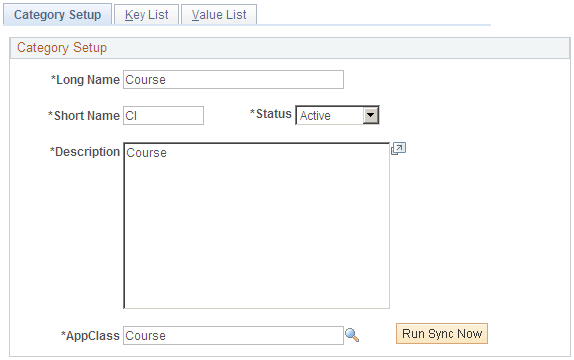
Field or Control |
Description |
|---|---|
AppClass (application class) |
The application class associated with the category. Each category needs a corresponding appclass of the type Datamapping, that has been registered in the Application Class Registry component (HRS_APPCLASS). The category forms the definition of the type of datamapping, while the appclass does the work of synchronizing the data from the original record into the datamapping tables. |
Run Sync Now (run synchronization now) |
Use when setting up new categories to synchronize the data associated with the selected data mapping category with the data actually existing in the corresponding component. This process populates the Key List and Value List pages. |
Use the Key List page (HRS_DM_CAT_KEYLIST) to view key lists.
Navigation:
This example illustrates the fields and controls on the Key List page.
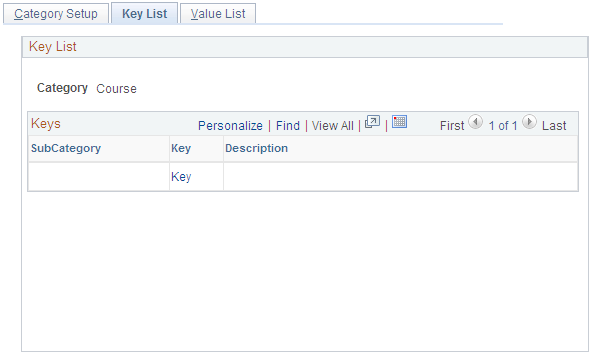
Field or Control |
Description |
|---|---|
Subcategory |
Serves as a secondary key for the data mapping functionality. Not all categories use the subcategory secondary key. Subcategories themselves must also be data mappings. |
Keys |
Displays the primary key for the category. These keys are determined by the data in the associated data mapping category tables. Click the key link to access the Key Data Mapping page. This page displays all the values that are mapped to the given key. |
Use the Value List page (HRS_DM_CAT_VALLIST) to view value lists.
Navigation:
This example illustrates the fields and controls on the Value List page.
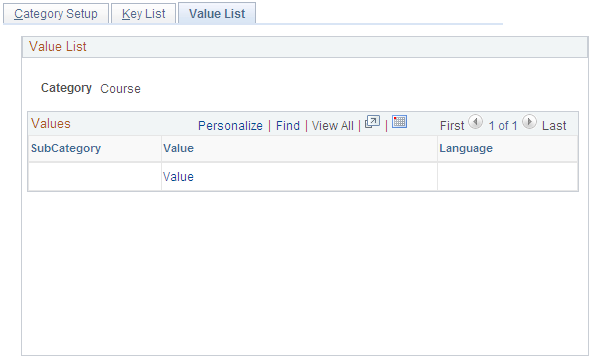
The Value List page lists all the values that are being mapped to a category key. Click a link in the Keys column to access the Value Data Mapping page.
Use the Unmapped Data page (HRS_DM_UNMAPPED) to map unmapped data.
Navigation:
This example illustrates the fields and controls on the Unmapped Data page.
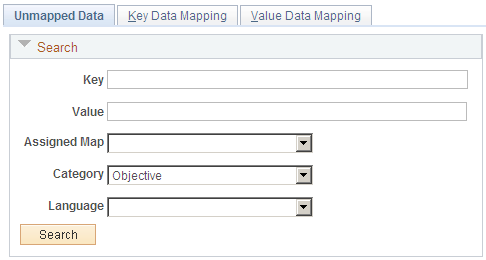
Field or Control |
Description |
|---|---|
Minimum Score |
Identifies a threshold for the Make Suggestions search. Only results that are greater than or equal to the minimum score appear in the Key ID field. The score of every suggestion found appears to the right of each key ID item in parentheses. |
Make Suggestions |
Click to run a search that provides a suggested mapping based on the minimum score that you entered. |
Use the Key Data Mapping page (HRS_DM_MAPING_DICT) to map keys.
Navigation:
This example illustrates the fields and controls on the Key Data Mapping page.
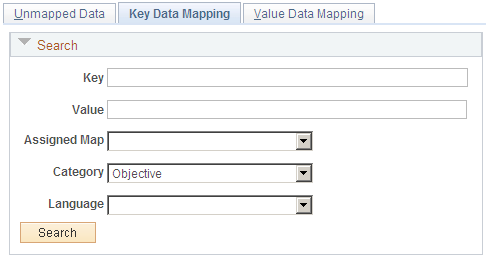
This page displays a complete list of all the values that are mapped to a given key.
Values
This group box enables you to add other values to the key. The values must be chosen from the unmapped data values.
Field or Control |
Description |
|---|---|
Value |
Select the values that are associated with the key. |
Assigned Map |
Select the data mapping assignment that the key is associated with. |
Language Code |
Select the language that the value is assigned to. |
Use |
Select to use this data mapping for incoming data, outgoing data, or both. |
Insert |
Click to add a row to the group box. |
Use the Value Data Mapping page (HRS_DM_VALUE) to map values.
Navigation:
This example illustrates the fields and controls on the Value Data Mapping page.
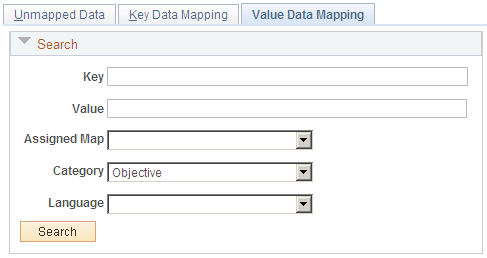
Displays all the keys that are mapped to the given value.
Keys
This group box displays all the keys that are mapped to the value and enables you to map more keys to the value. The keys that you add come from the unmapped data values.
Field or Control |
Description |
|---|---|
Key |
Select the key ID of the data mapping. |
Assigned Mapping ID |
Select the data mapping assignment that the key is associated with. |
Use |
Select to use this data mapping for incoming data, outgoing data, or both. |